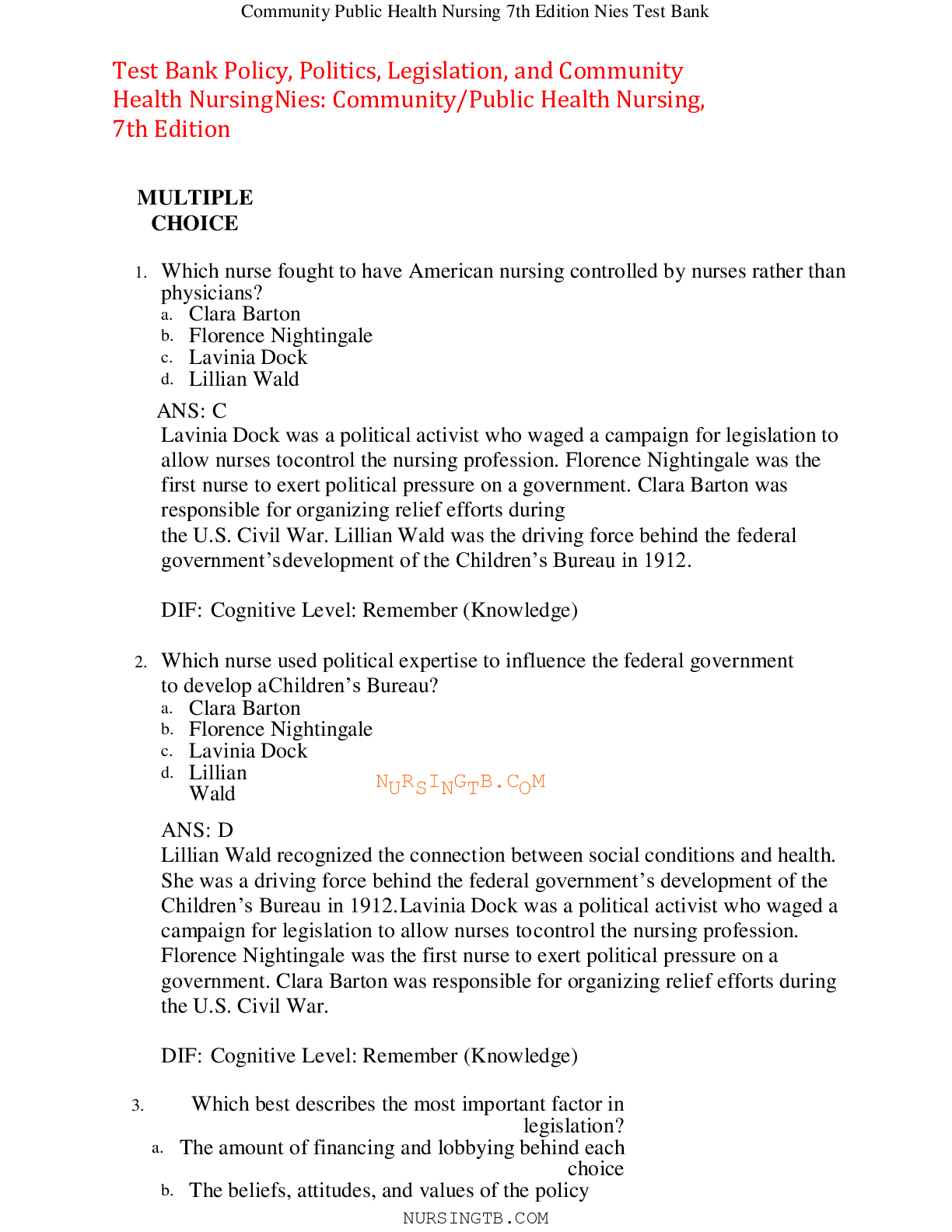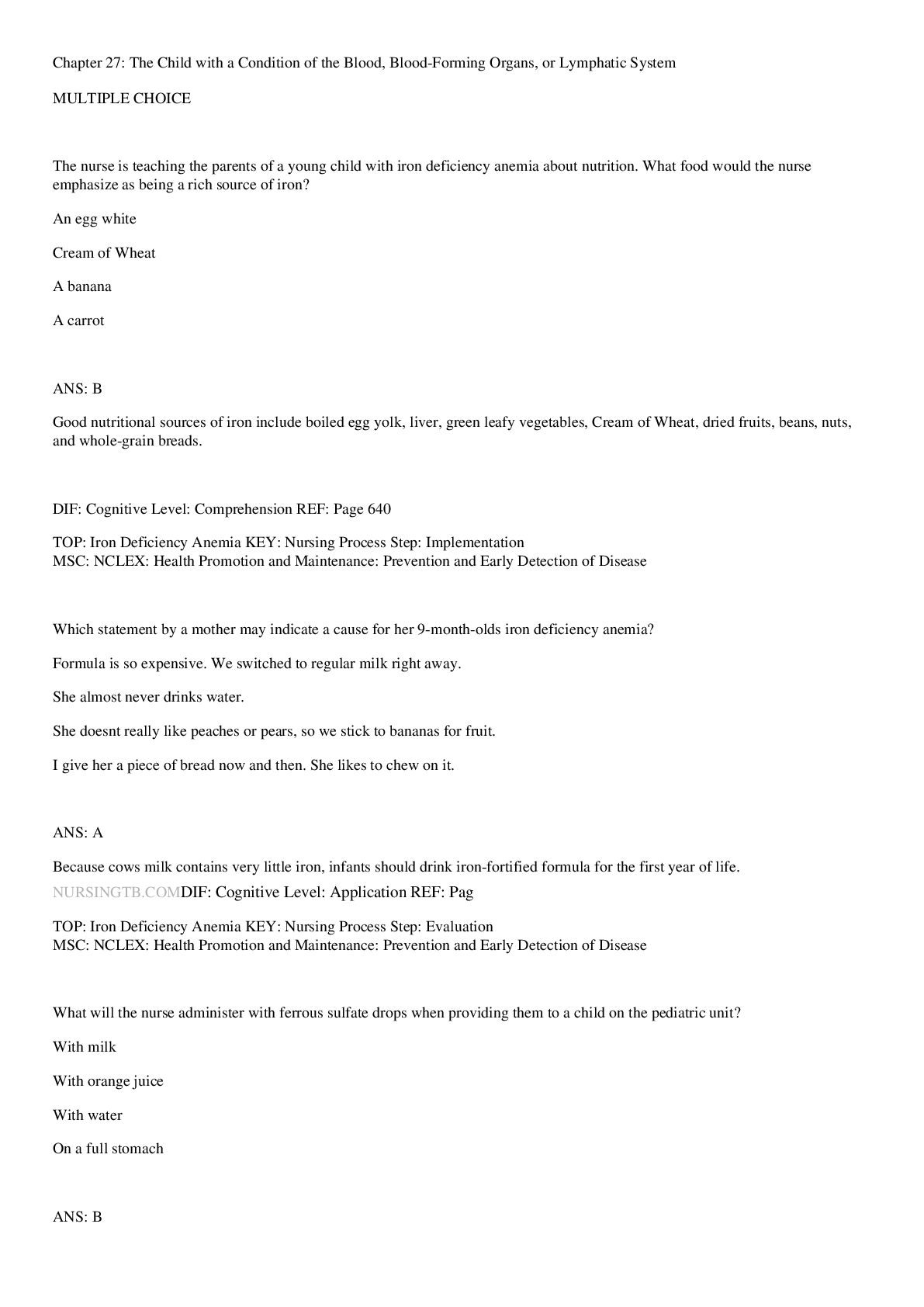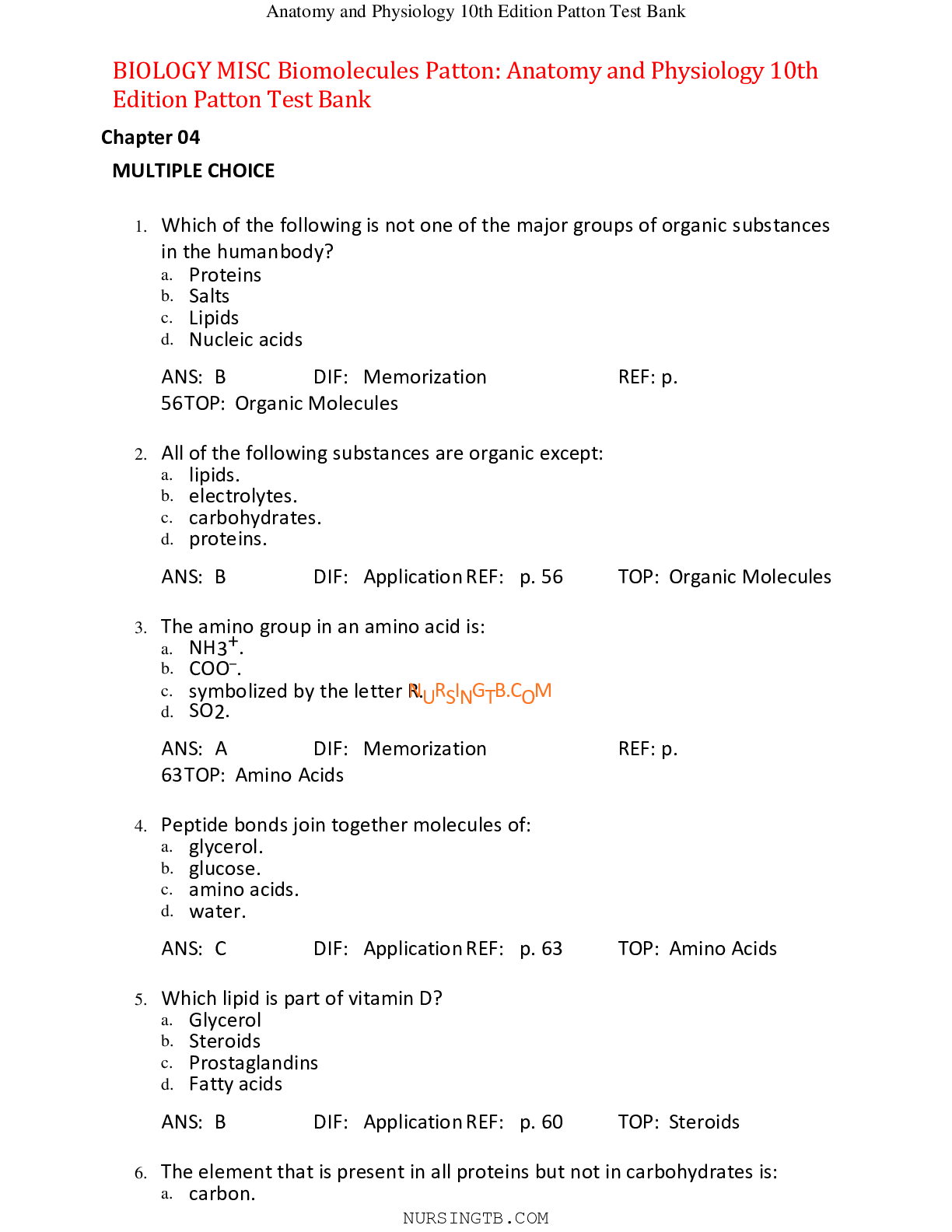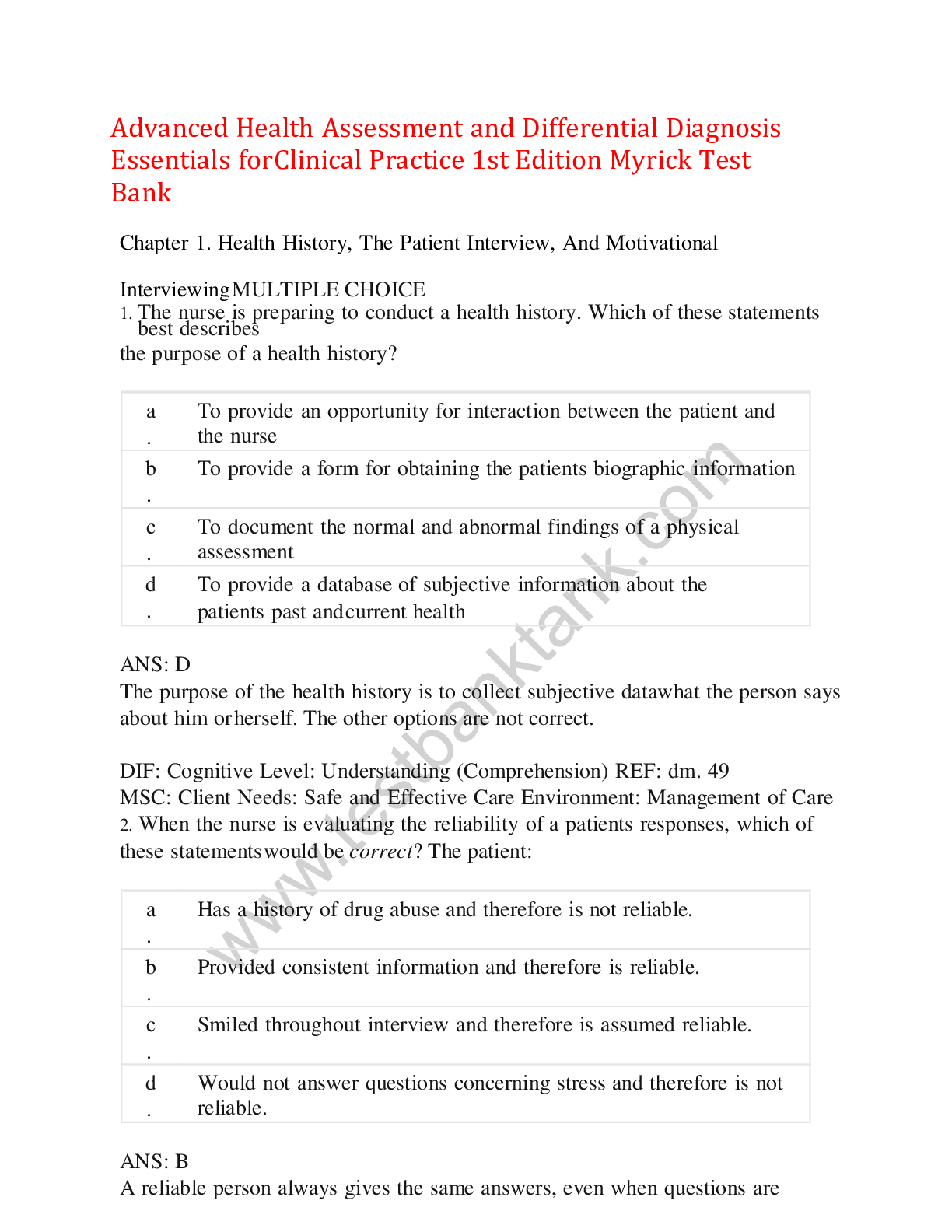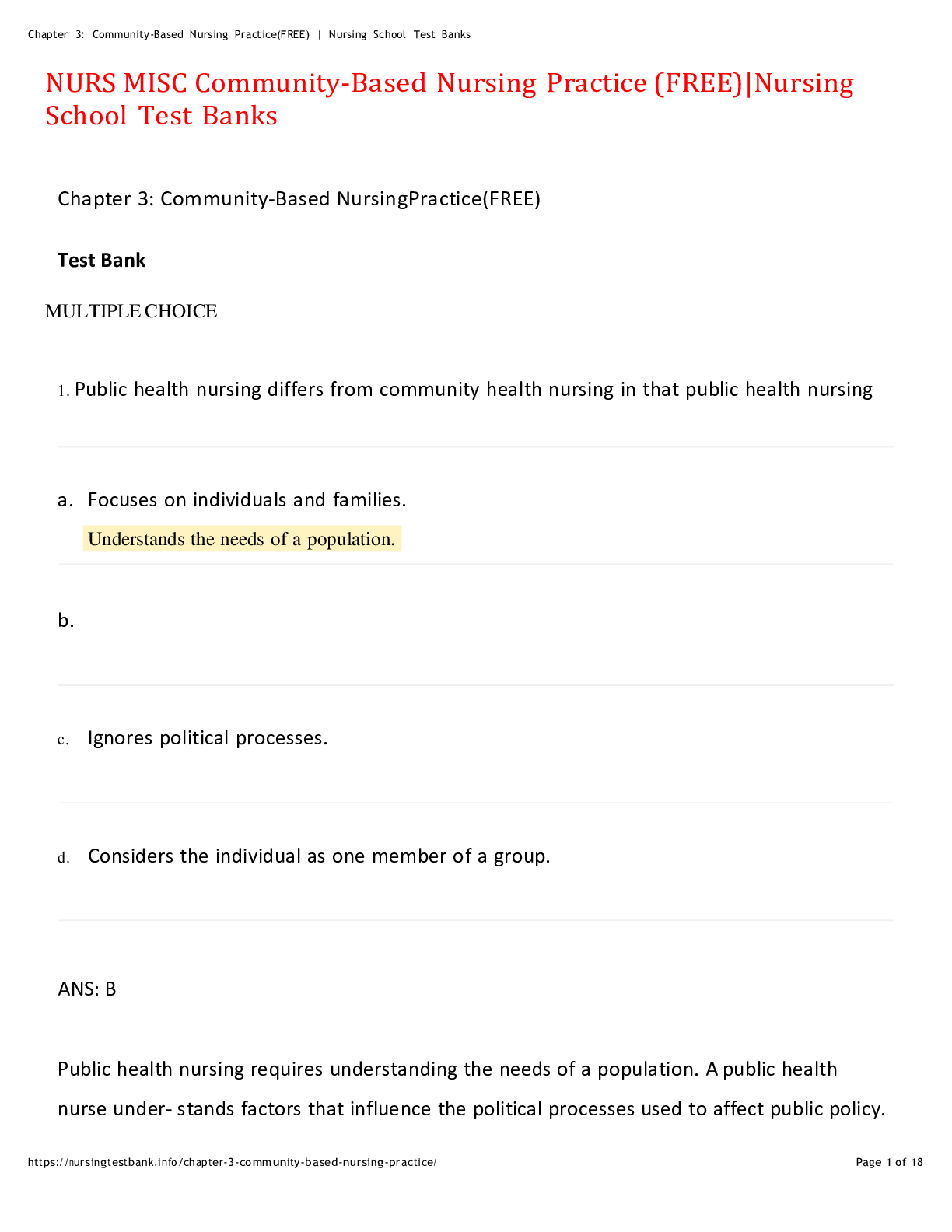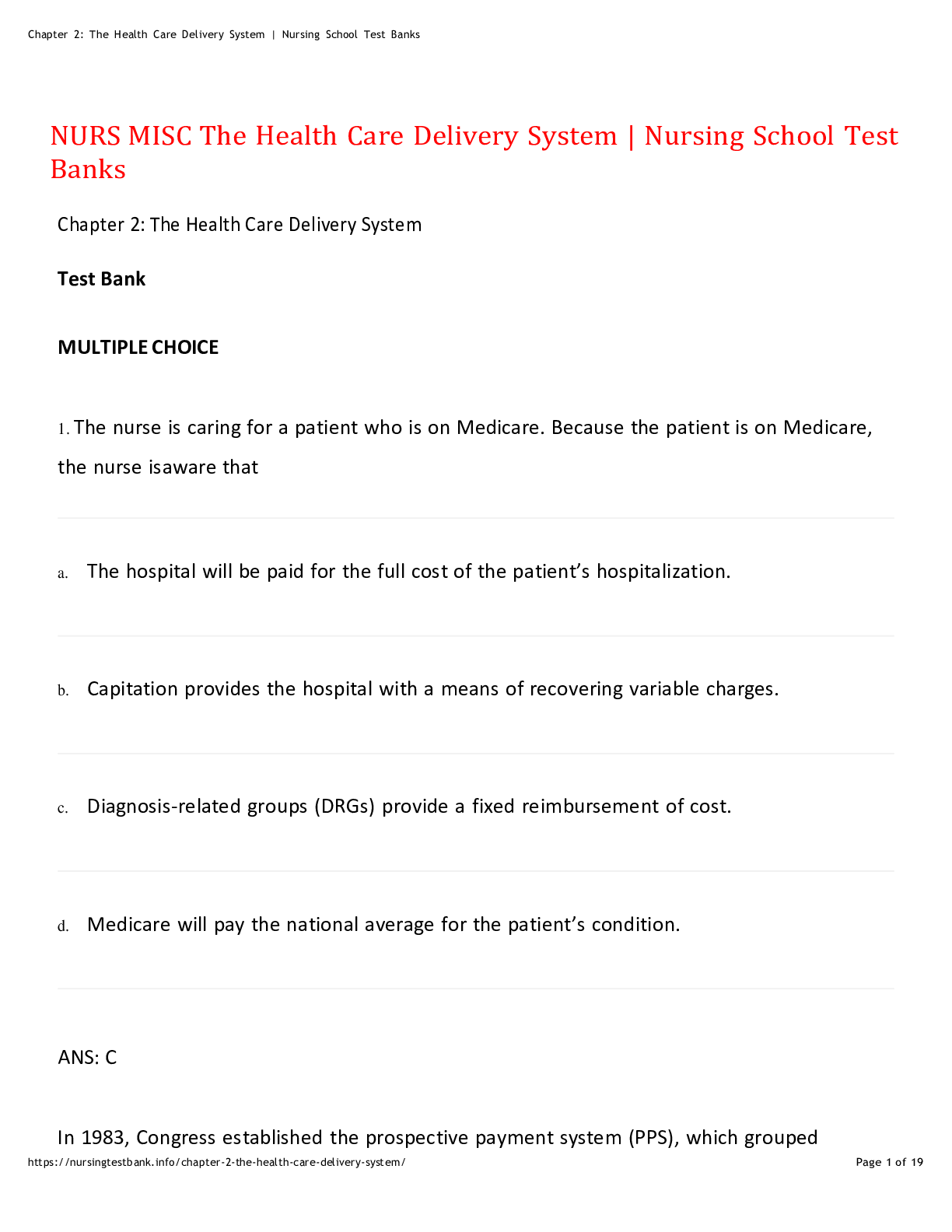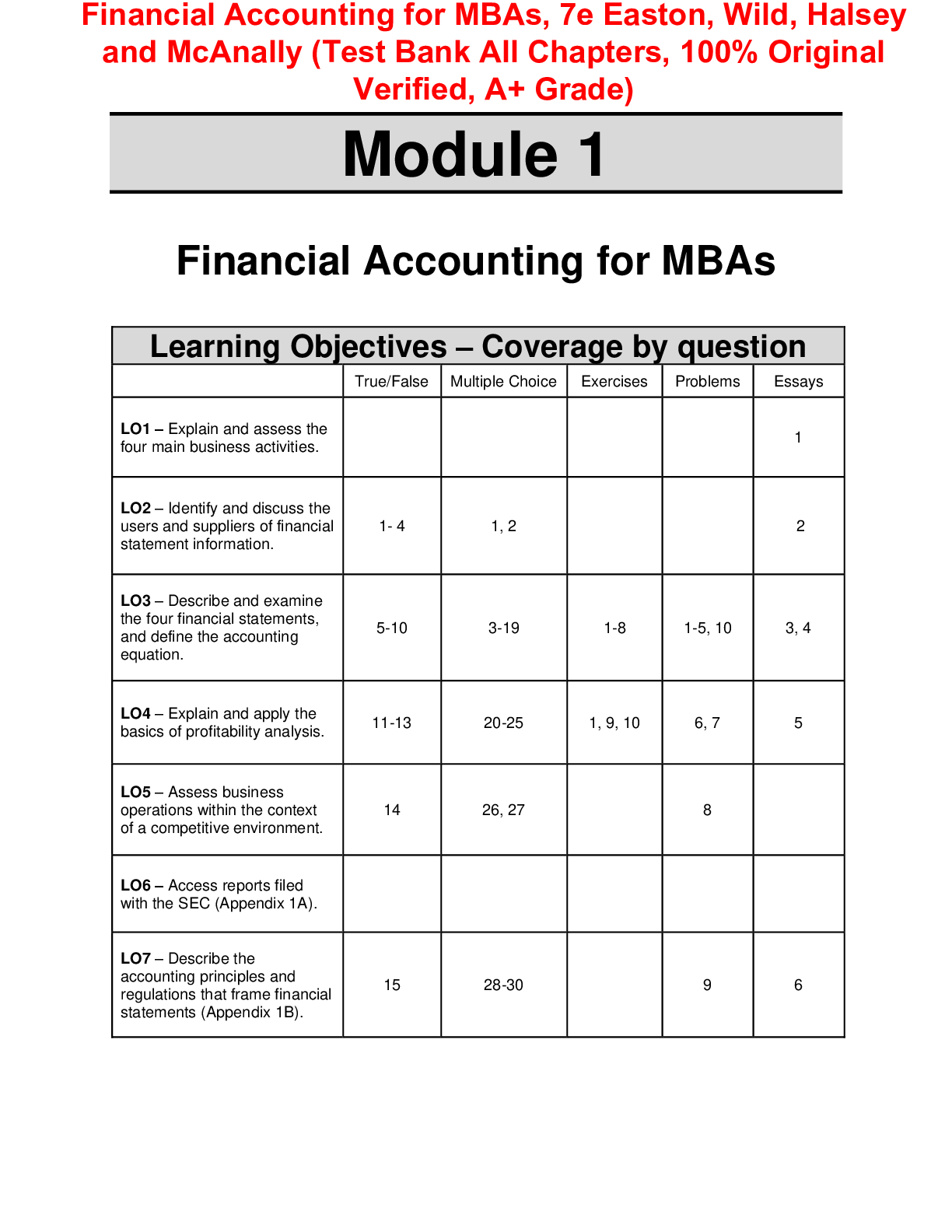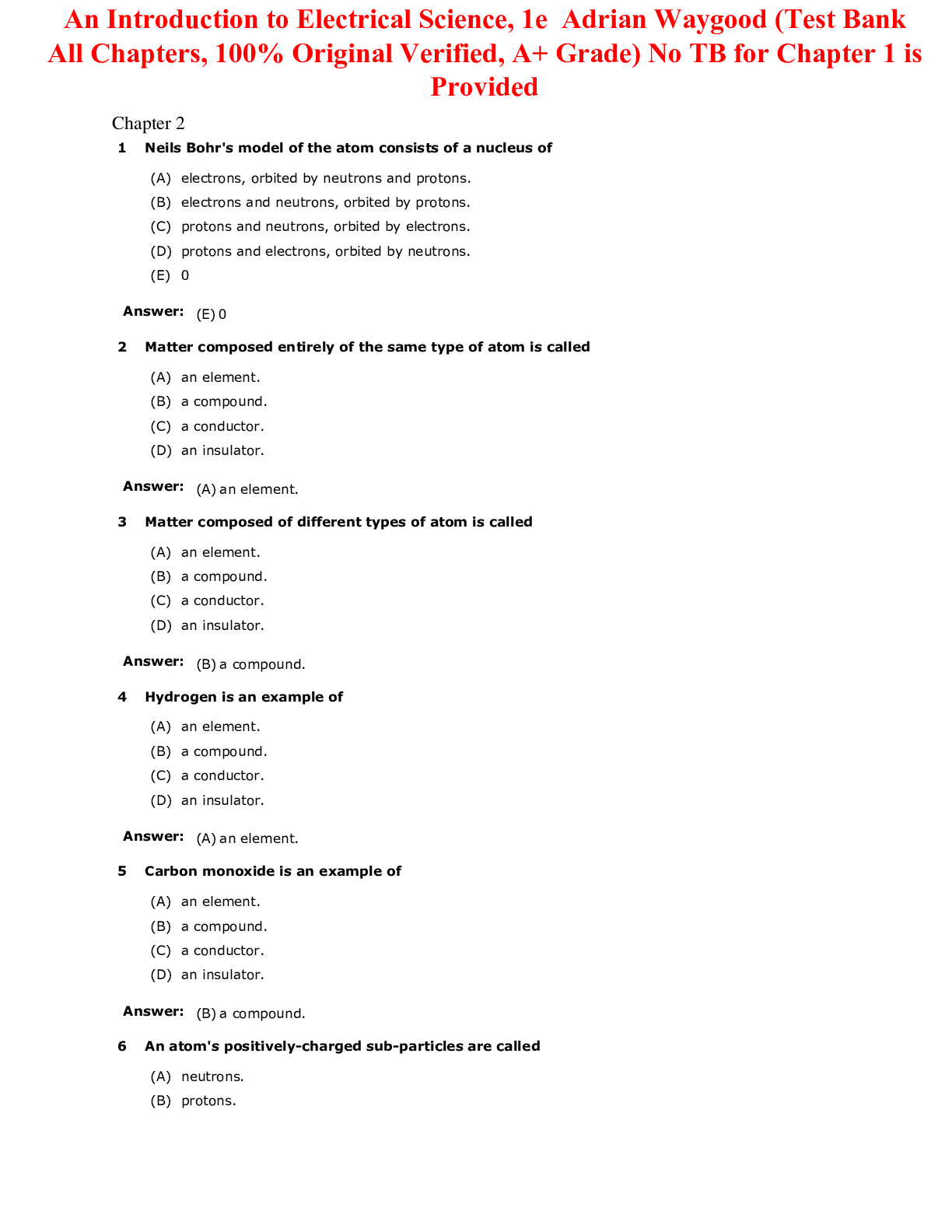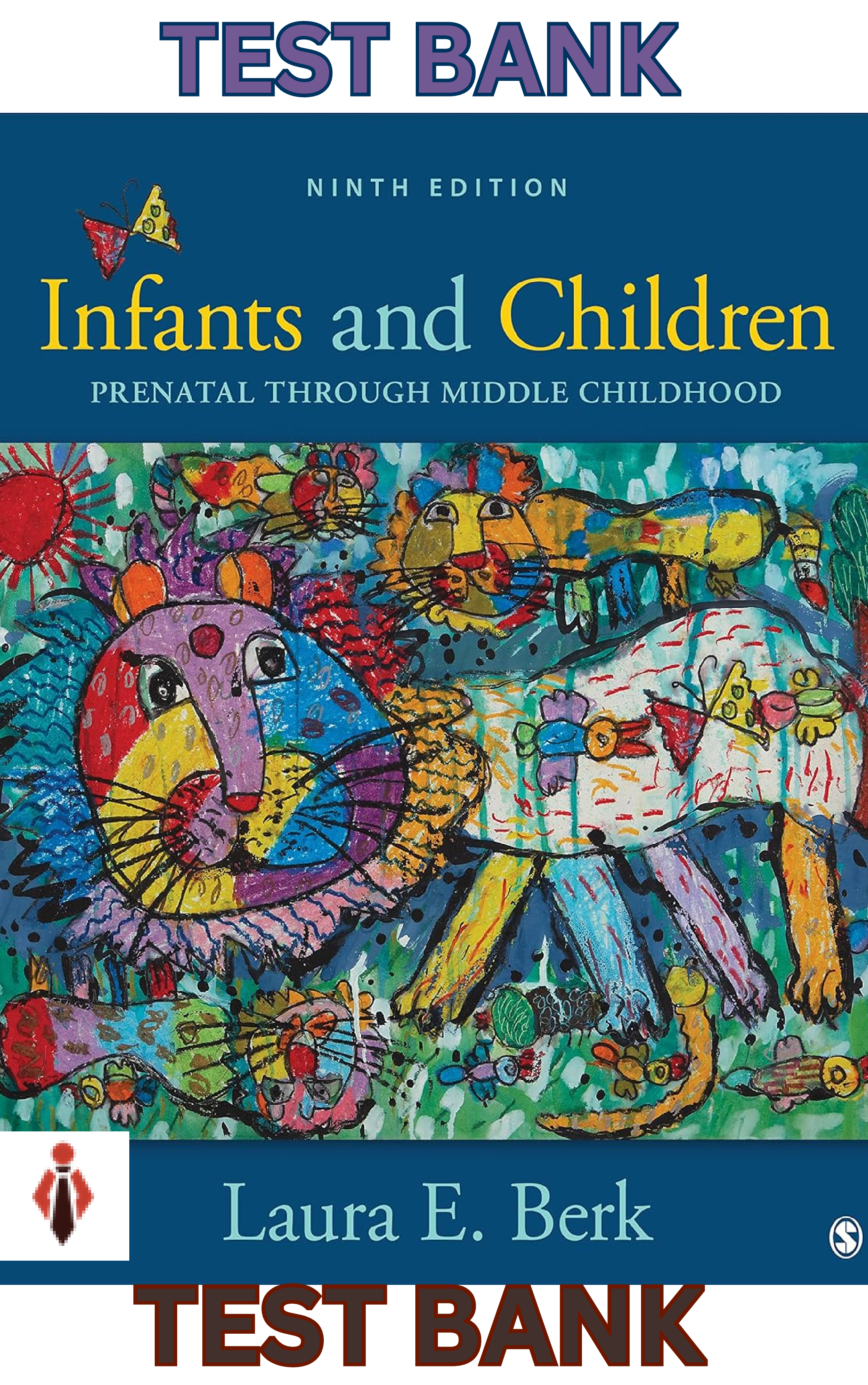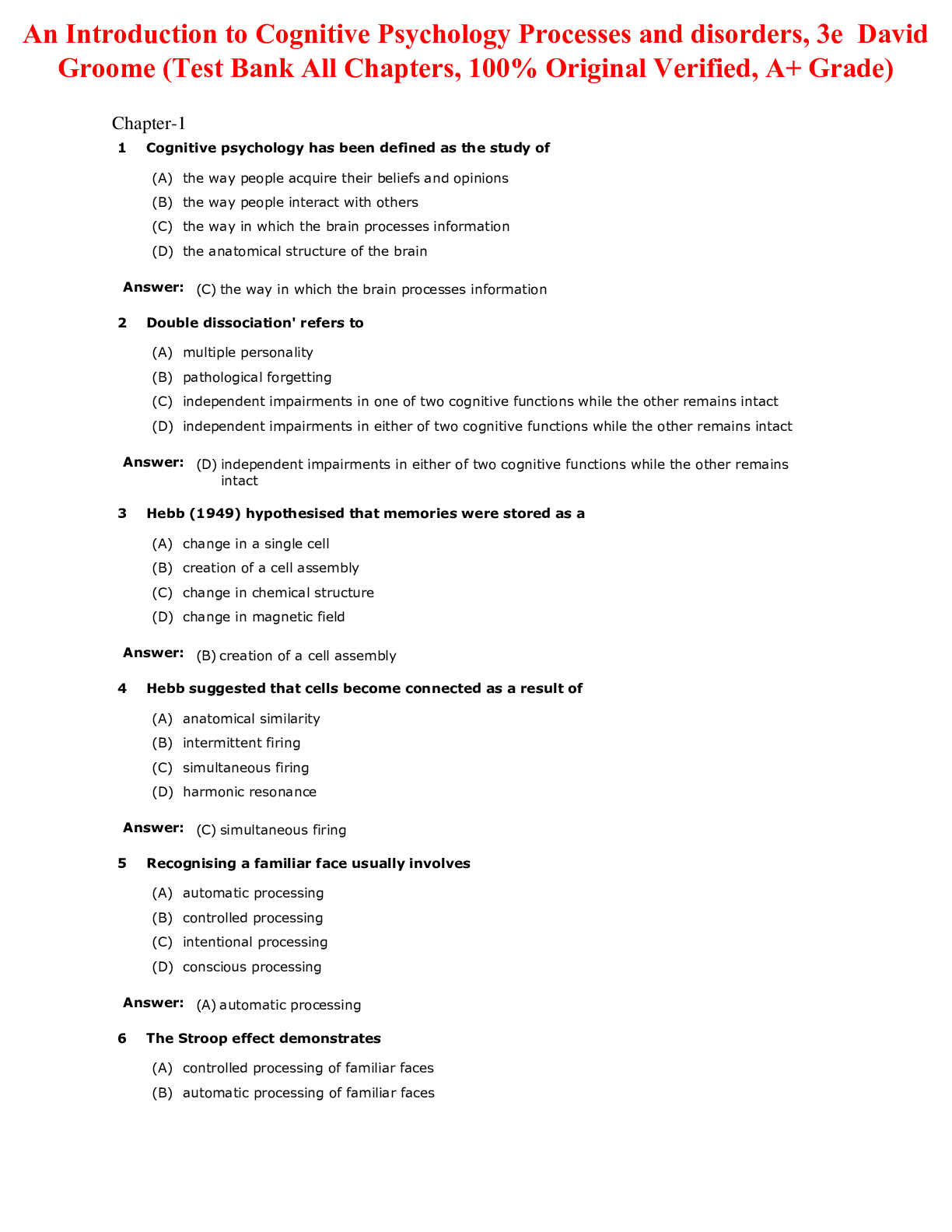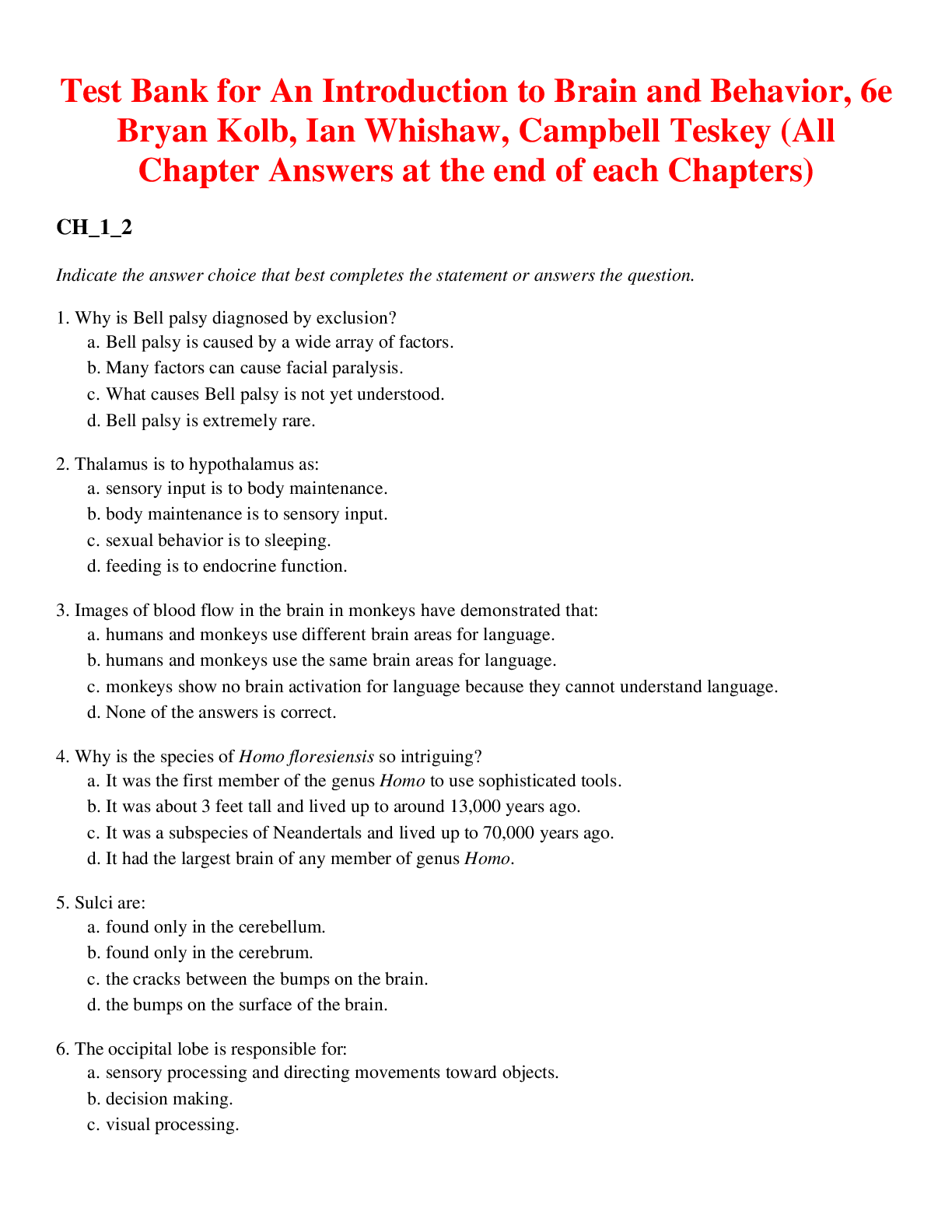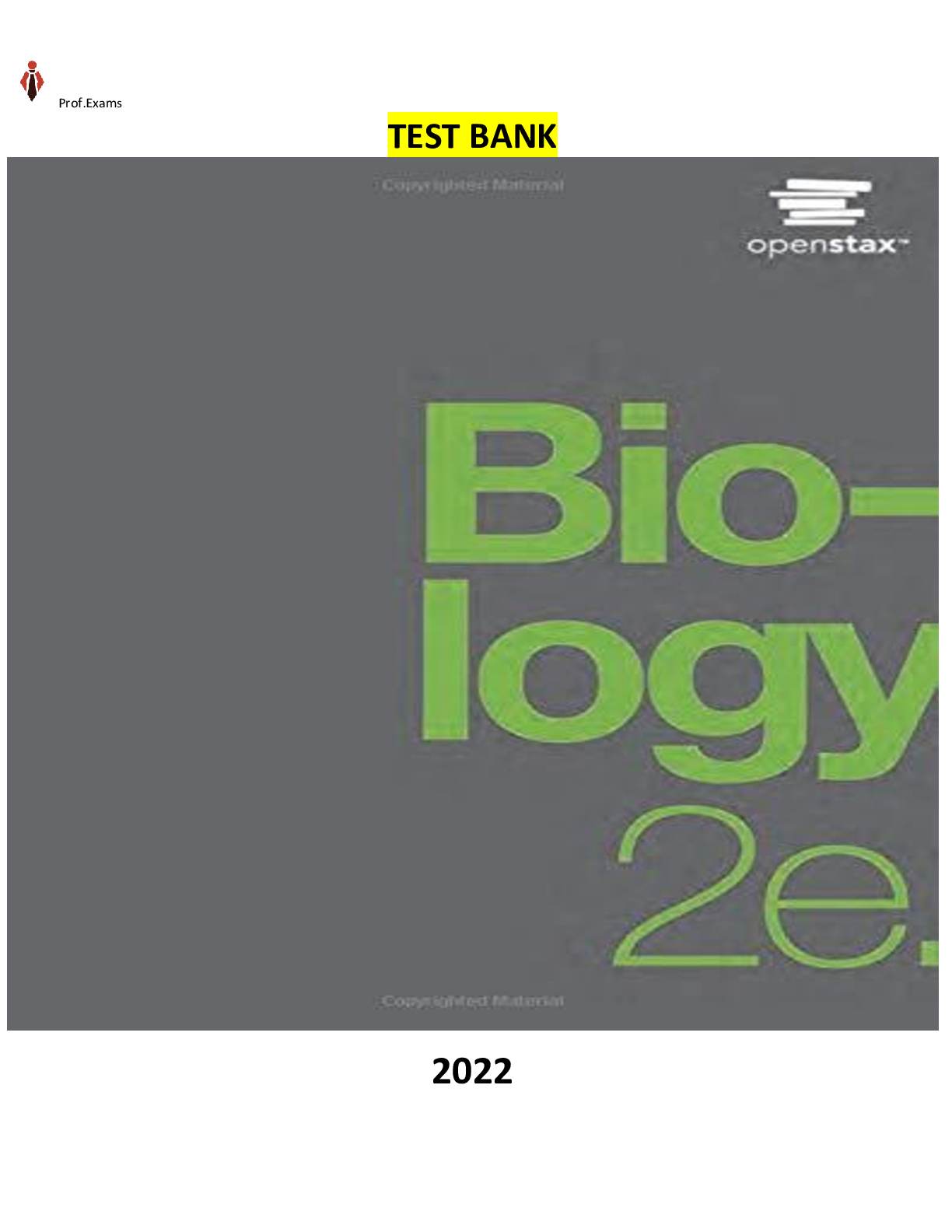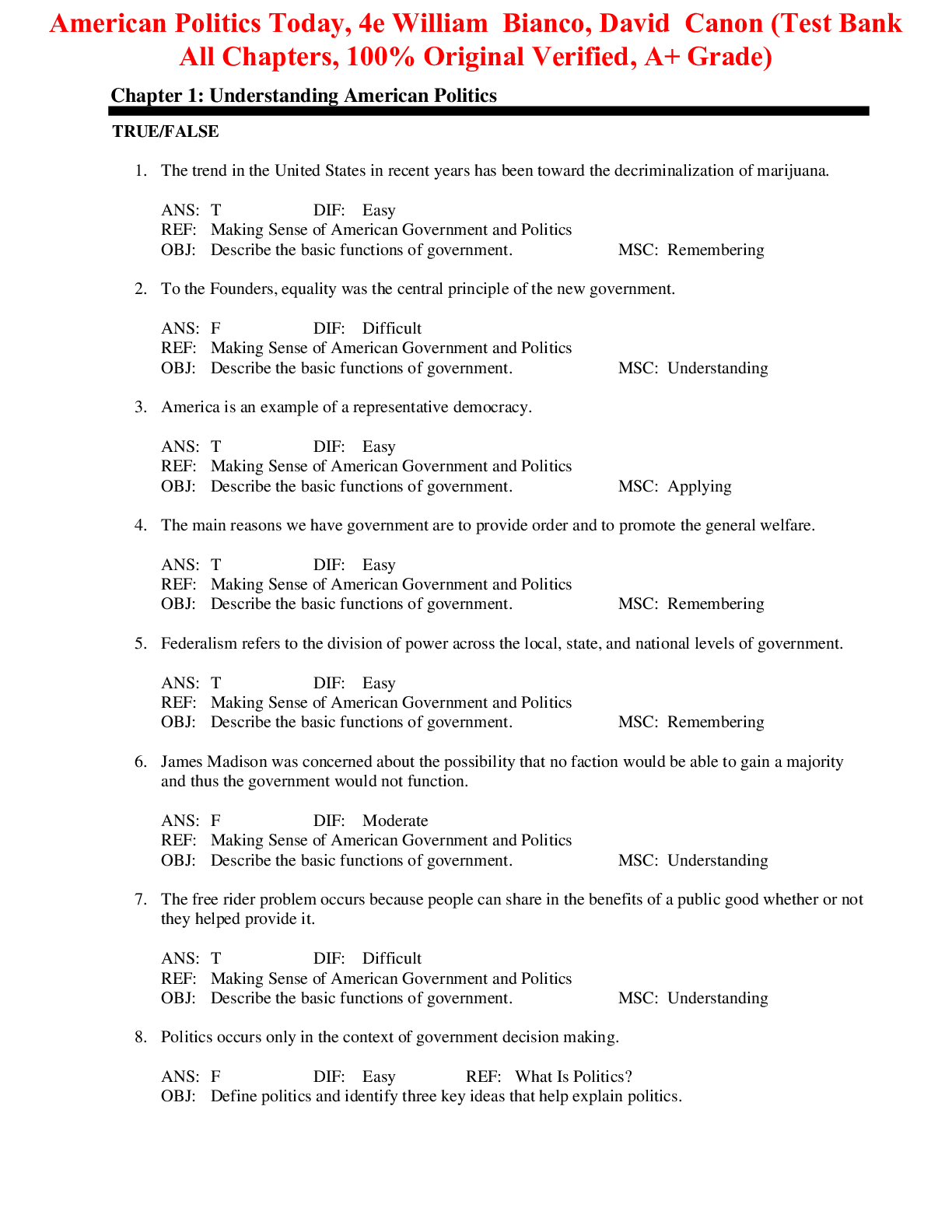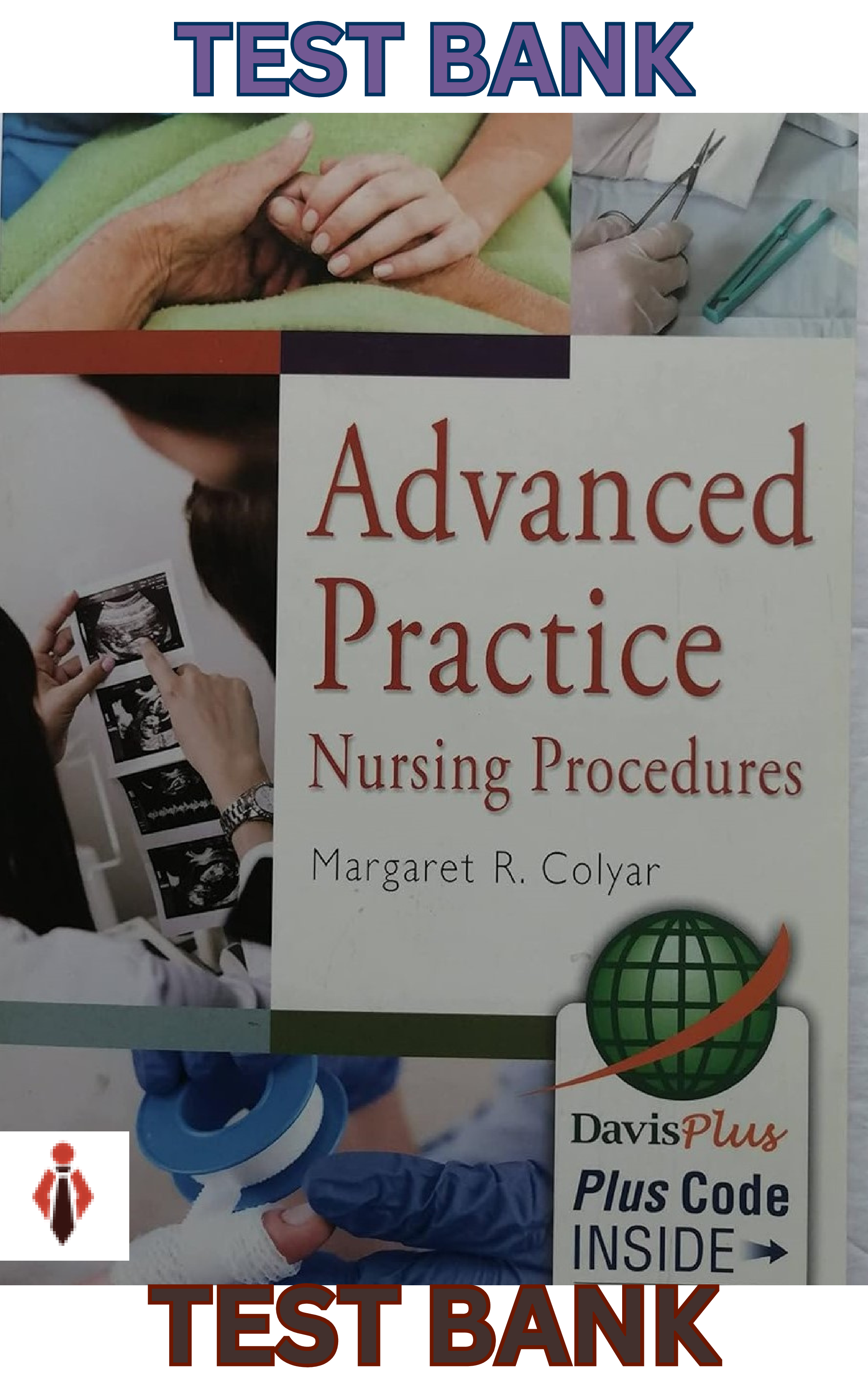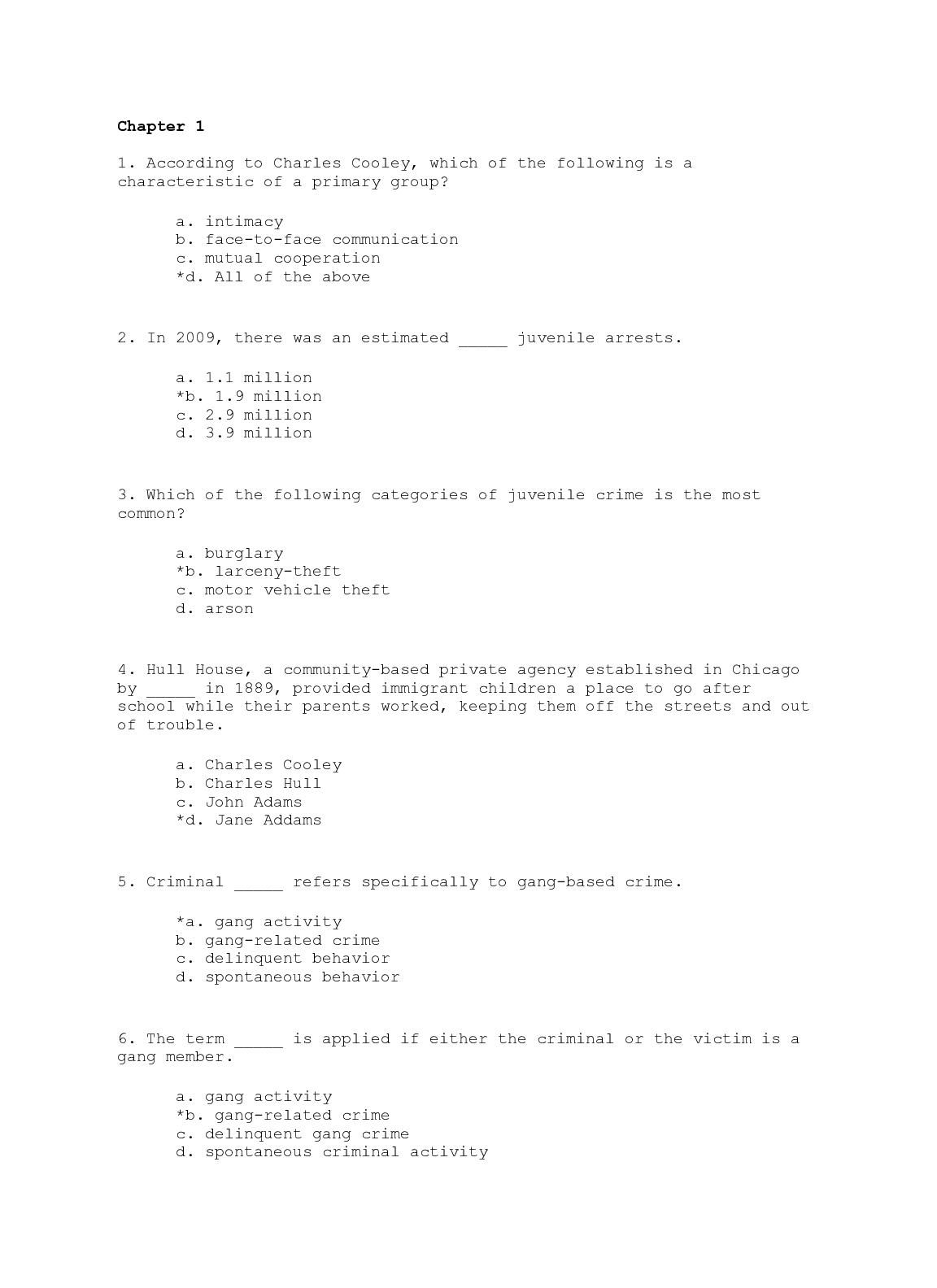*NURSING > TEST BANK > NURS MISC Theoretical Foundations of Nursing Practice(FREE)| Nursing School Test Banks,100% CORRECT (All)
NURS MISC Theoretical Foundations of Nursing Practice(FREE)| Nursing School Test Banks,100% CORRECT
Document Content and Description Below
NURS MISC Theoretical Foundations of Nursing Practice(FREE)| Nursing School Test Banks Chapter 4: Theoretical Foundations of Nursing Practice(FREE) Test Bank MULTIPLE CHOICE 1. The nursing... instructor is teaching a class on nursing theory. One of the students asks, “Why do we need to know this stuff? It doesn’t really affect patients.” The instructor’s best response would be a. “You are correct, but we have to learn it anyway.” b. “Exposure to theories will help you later in graduate school.” c. “Theories help keep the focus of nursing narrow.” d. ANS: D Theories offer well-grounded rationales or reasons for how and why nurses perform specific interven- tions. Learning about theories is important because these theories help to describe, explain, predict, and/or prescribe nursing care measures. Although nursing theory will help the nurse in graduate school, it is also an important basis for the nurse’s approach to daily patient care, and it expands scientific knowledge of the profession. DIF: Understand REF: 40 OBJ: Explain the influence of nursing theory on a nurse’s approach to practice. TOP: Evaluation MSC: Teaching/Learning 2. The nurse is caring for a patient who is known as a “frequent flyer,” and who has been labeled as “noncompliant” by most of the staff because she does not follow her prescribed regimen for diabetes management. As a prescriber to Orem’s theory, the nurse interviews the patient in an attempt to identify the cause of the patient’s “noncompliance.” This is because Orem’s theory a. b. Does not allow for environmental influences on care. c. Allows for development of a plan of care that the patient must follow. d. Is not useful in promoting self-care regimens. ANS: A Orem’s theory explains the factors within a patient’s living situation that support or interfere with the pa- tient’s self-care ability. This theory has value in helping nursing design interventions with the patient that will help to promote the patient’s self-care in managing an illness, such as diabetes or arthritis. DIF: Understand REF: 41 OBJ: Explain the influence of nursing theory on a nurse’s approach to practice. TOP: Implementation MSC: Caring 3. The type of theory that is used to theory. a. Grand b. nursing interventions is known as c. Descriptive d. Middle-range ANS: B Prescriptive theories are action oriented and test the validity and predictability of a nursing intervention. These theories guide nursing research to develop and test specific nursing interventions. Grand theories are broad in scope and complex, and require further specification through research. Descriptive theories do not direct specific nursing activities but help to explain patient assessment. The phenomena within middle-range theories tend to cross different nursing fields and reflect a wide variety of nursing care situations. DIF: Knowledge REF: 42 OBJ: Describe types of nursing theories. TOP: Implementation MSC: Caring 4. The nurse researcher is evaluating whether holding pressure at an injection site after injecting the anti- coagulant enoxaparin (Lovenox) will reduce bruising at the injection site. This study involves a prescrip- tive theory because it a. b. Explains why bruising occurs. c. Is broad in scope and complex. d. Reflects a wide variety of nursing care situations. ANS: A Prescriptive theories guide nursing research to develop and test specific nursing interventions. Grand theories are broad in scope and complex, and require further specification through research. Descriptive theories do not direct specific nursing activities but help to explain patient assessment. The phenomena within middle-range theories tend to cross different nursing fields and reflect a wide variety of nursing care situations. DIF: Understand REF: 42 OBJ: Describe types of nursing theories. TOP: Implementation MSC: Caring 5. The student nurse is learning nursing theories but fails to see how they relate to the nursing process. The professional nurse realizes that nursing theory a. Has a minor role in professional nursing. b. Requires the nursing process to develop knowledge. c. d. is specific to certain patients only. ANS: C Nursing theory can direct how a nurse uses the nursing process. Integration of theory into practice serves as the basis for professional nursing. The nursing process provides a systematic process for the delivery of care, not the knowledge component of the discipline. Useful theories are adaptable to different pa- tients and to all care settings. DIF: Understand REF: 43 OBJ: Describe the relationship between theory, the nursing process, and patient needs. TOP: Implementation MSC: Caring 6. A system is made up of separate components. A closed system a. Interacts with the environment. b. Is exemplified by the human organism. c. d. Is exemplified by the nursing process. ANS: C Two types of systems have been identified: open and closed. An open system, such as a human organism or processes like the nursing process, interacts with the environment. A closed system does not interact with the environment. DIF: Knowledge REF: 43 OBJ: Discuss selected theories from other disciplines. TOP: Assessment MSC: Nursing Process 7. The nurse is caring for a patient diagnosed with essential hypertension. The physician orders blood pressure medication that the nurse administers. The nurse then monitors the patient’s blood pressure for several days to help determine the effectiveness of the administration. In doing so, the nurse evaluates which of the following system components? a. Input b. c. Feedback d. Content ANS: B Output is the end product of a system and, in the case of the nursing process, it is defined as whether the patient’s health status improves or remains stable as a result of nursing care. Input consists of the data that come from a patient’s assessment. Feedback serves to inform a system about how it functions. Con- tent is the product and information obtained from the system. DIF: Understand REF: 43 OBJ: Discuss selected theories from other disciplines. TOP: Implementation MSC: Caring 8. The patient is admitted to the ICU to rule out a myocardial infarction (MI). During the admission process, the patient is noted to have a history of methicillin-resistant Staphylococcus aureus (MRSA) and is placed in isolation until cultures can be obtained and the patient declared noninfectious. During the isolation process, the nurse encourages family visits, realizing that which level of Maslow’s hierar- chy of needs is at risk? a. First level b. Second level c. d. Fourth level e. Fifth level ANS: C The third level contains love and belonging needs, including friendship, social relationships, and sexual love. The first level includes physiological needs. The second level includes safety and security needs. The fourth level encompasses esteem and self-esteem needs. The fifth and final level is the need for self- actualization. DIF: Understand REF: 43 OBJ: Discuss selected theories from other disciplines. TOP: Implementation MSC: Caring 9. Many aspects of nursing theory are based on developmental theories because human growth and de- velopment is believed to be a. Erratic and difficult to predict. b. c. An orderly process until adulthood. d. Unpredictable during childhood. ANS: B Human growth and development is an orderly predictive process that begins with conception and contin- ues through death. It is not erratic or difficult to predict. It does not stop at adulthood and is not unpre- dictable during childhood. DIF: Understand REF: 44 OBJ: Discuss selected theories from other disciplines. TOP: Implementation MSC: Caring 10. The nurse is making rounds and finds her older adult patient sobbing and obviously upset. She states that her doctor told her that she has cancer, and she does not want to die. “What’s the sense?” she says. “I might as well die. I’m going to anyway. I guess that shows how useless I really am. Nobody wants an old lady around.” The nurse notices that the patient’s respirations have increased, and the tip of her nose and ear lobes are becoming cyanotic. The nurse assesses the patient and finds that the patient’s pulse rate is over 150 beats per minute. According to Maslow’s hierarchy of needs, the nurse should first a. Call the physician to request a psychiatric consult. b. Reassure the patient that she has value as a human being. c. d. Call the patient’s family to help her realize that she is wanted. ANS: C Maslow’s hierarchy is useful in setting patient priorities. Basic physiological and safety needs are usual- ly the first priority. These include physiological needs such as air, water, and food. Cyanosis and fast heart rate are indicators of physiological stress and must be dealt with first, or the patient may not sur- vive. The second level includes psychological security. A psychiatric consult would come after physio- logical stabilization. The third level includes love and belonging needs that would also need to be ad- dressed, and the family may be helpful in dealing with this, once the patient is stabilized. The fourth lev- el involves self-esteem, which would also need to be addressed. DIF: Apply REF: 43 OBJ: Discuss selected theories from other disciplines. TOP: Implementation MSC: Caring 11. As the initial model for nursing, Nightingale’s “descriptive theory” encouraged nurses to a. b. Think about their patients and patients’ environment. c. Combine nursing knowledge with medicine. d. Focus on medication administration and treatments. ANS: B Nightingale’s “descriptive theory” provides nurses with a way to think about patients and their environ- ment. Nightingale’s concept of the environment was the focus of nursing care, and her suggestion that nurses need not know all about the disease process represents early attempts to differentiate between nursing and medicine. Nightingale did not view nursing as limited to the administration of medications and treatments. DIF: Understand REF: 44 OBJ: Discuss selected nursing theories. TOP: Implementation MSC: Caring 12. The nurse is visiting a patient at home after he was discharged from the hospital following a heart at- tack. She listens to the patient’s concerns about being an invalid for the rest of his life because of his bad heart, but he is afraid of having “open heart” surgery. The nurse explains the different surgical proce- dures that are available to the patient, as well as other options such as cardiac rehabilitation. After sever- al such visits, the patient states that he believes that cardiac rehabilitation therapy would be best for him, and asks the nurse how he can get in. The nurse calls the patient’s physician and sets up a referral for cardiac rehabilitation. This action most closely fits which of the following theories? a. b. Henderson’s theory c. Nightingale’s theory d. Orem’s self-care deficit theory ANS: A Henderson’s theory focuses on helping the patient with activities that the patient would perform unaided if he or she were able. Nightingale viewed nursing not as limited to the administration of med- ications and treatments, but rather as oriented toward providing fresh air, light, warmth, cleanliness, qui- et, and adequate nutrition. The goal of Orem’s theory is to help the patient perform self-care. DIF: Apply REF: 44 OBJ: Discuss selected nursing theories. TOP: Implementation MSC: Nursing Process 13. The nurse is caring for a patient who is actively bleeding. The physician orders blood transfusions. The nurse notes in the chart that the patient is a Jehovah’s Witness and informs the patient of the physi- cian’s order. The patient states that she is a Jehovah’s Witness and does not want blood products. The nurse contacts the physician to tell him that blood cannot be given to this patient and requests alternative treatment. In doing so, the nurse is operating within which of the following theories? a. Leininger’s cultural care diversity and universality theory b. Roy’s adaptation theory c. Watson’s philosophy of transpersonal caring d. Orem’s self-care deficit theory ANS: A The goal of Leininger’s theory is to provide the patient with culturally specific nursing care that inte- grates the patient’s cultural traditions, values, and beliefs into the plan of care. The goal of Roy’s model is to help the person adapt to changes in physiological needs, self-concept, role function, and relations. Watson’s theory believes that the purpose of nursing action is to understand the interrelationship be- tween health, illness, and human behavior. The goal of Orem’s theory is to help the patient perform self- care. DIF: Understand REF: 44-46 OBJ: Discuss selected nursing theories. TOP: Implementation MSC: Nursing Process 14. The patient is terminally ill and is under hospice care. The nurse cares for the patient by bathing, shaving, and repositioning him. The family believes that the end is very near and would like a Catholic priest called to provide the patient with the Sacrament of the Sick. The nurse places a call to the Catholic Church the patient attended and arranges for the priest’s visit. Under which of the following theories does the nurse’s care fall? a. Roy’s adaptation theory b. Watson’s philosophy of transpersonal caring c. Henderson’s theory d. Orem’s self-care deficit theory ANS: C Henderson defines nursing as “assisting the individual, sick or well, in the performance of those activi- ties that will contribute to health, recovery, or a peaceful death, and that the individual would perform unaided if he or she had the necessary strength, will, or knowledge.” Roy’s model is to help the person adapt to changes in physiological needs, self-concept, role function, and relations. Watson’s theory be- lieves that the purpose of nursing action is to understand the interrelationship between health, illness, and human behavior. The goal of Orem’s theory is to help the patient perform self-care. DIF: Understand REF: 44-46 OBJ: Discuss selected nursing theories. TOP: Implementation MSC: Nursing Process 15. The patient is newly diagnosed with diabetes and will be discharged in the next day or so. The nurse is teaching the patient how to draw up and self-administer his insulin. Which nursing theory is the nurse utilizing? a. Watson’s philosophy of transpersonal caring b. Orem’s self-care deficit theory c. Rogers’ theory d. Henderson’s theory ANS: B The goal of Orem’s theory is to help the patient perform self-care. In Watson’s theory, the nurse is con- cerned with promoting and restoring health and preventing illness. Rogers’ theory considers the individ- ual as an energy field coexisting within the universe. Henderson defines nursing as “assisting the indi- vidual, sick or well, in the performance of those activities that will contribute to health, recovery, or a peaceful death, and that the individual would perform unaided if he or she had the necessary strength, will, or knowledge.” DIF: Apply REF: 44-46 OBJ: Discuss selected nursing theories. TOP: Implementation MSC: Nursing Process 16. The prospective nursing student is trying to decide on which nursing program to attend. She is exam- ining the nursing philosophies of each program. She believes that the essence of nursing is “Caring.” Which of the following theories would most likely meet her needs? a. Benner and Wrubel’s theory of nursing b. Roy’s adaptation theory c. Orem’s self-care deficit theory d. Rogers’ theory ANS: A The primacy of caring is a model proposed by Patricia Benner and Judith Wrubel. Caring is central. Roy’s model is to help the person adapt to changes in physiological needs, self-concept, role function, and relations. The goal of Orem’s theory is to help the patient perform self-care. Roger’s theory consid- ers the individual as an energy field coexisting within the universe. DIF: Evaluation REF: 44-46 OBJ: Discuss selected nursing theories. TOP: Implementation MSC: Nursing Process 17. The nursing process is a. The generation of nursing knowledge for use in practice. b. A systematic view of a phenomenon specific to inquiry. c. A method used to inform a system about how it functions. d. A systematic process for the delivery of nursing care. ANS: D Although the nursing process is central to nursing, it is not a theory. It provides a systematic process for the delivery of nursing care. Theory generates nursing knowledge for use in practice. An in- terdisciplinary theory explains a systematic view of a phenomenon specific to the discipline of inquiry. Feedback serves to inform a system about how it functions. DIF: Knowledge REF: 43 OBJ: Describe theory-based nursing practice. TOP: Assessment MSC: Nursing Process 18. Nursing has its own body of knowledge that is both theoretical and practical. Which of the following is an example of theoretical knowledge? a. Reflection on care experiences b. Synthesis and integration of the art and science of nursing c. Reflection on basic values and principles d. Creating a narrow understanding of nursing practice ANS: C Theoretical knowledge includes and reflects on the basic values, guiding principles, elements, and phas- es of nursing. The goals of theoretical knowledge are to stimulate thinking and create a broad under- standing of the “science” and practices of the nursing discipline. Practical knowledge is achieved through personal knowing gained through reflection on care experiences, synthesis, and integration of the art and science of nursing. DIF: Understand REF: 46 OBJ: Describe theory-based nursing practice. TOP: Assessment MSC: Nursing Process MULTIPLE RESPONSE 1. A paradigm is useful in describing the domain of a discipline. Nursing’s paradigm includes which of the following? (Select all that apply.) a. Person b. Disease c. Health d. Environment e. Nursing ANS: A, C, D, E Nursing’s paradigm includes four linkages: the person, health, environment/situation, and nursing. Dis- ease is not part of nursing’s paradigm. DIF: Knowledge REF: 40-41 OBJ: Explain the influence of nursing theory on a nurse’s approach to practice. TOP: Diagnosing MSC: Teaching/Learning 2. Psychosocial theories are needed in nursing because nursing is a diverse discipline that strives to meet which criteria? (Select all that apply.) a. Physiological needs of the patient b. Psychological needs of the patient c. Sociocultural needs of the patient d. Spiritual needs of the patient e. The nurse-patient relationship ANS: A, B, C, D Nursing is a diverse discipline that strives to meet the physiologic, psychological, sociocultural, devel- opmental, and spiritual needs of patients. The nurse-patient relationship forms the basis for Hildegard Peplau’s theory of nursing. DIF: Understand REF: 44 OBJ: Discuss selected theories from other disciplines. TOP: Implementation MSC: Caring [Show More]
Last updated: 1 year ago
Preview 1 out of 18 pages
Instant download

Instant download
Reviews( 0 )
Document information
Connected school, study & course
About the document
Uploaded On
Nov 21, 2022
Number of pages
18
Written in
Additional information
This document has been written for:
Uploaded
Nov 21, 2022
Downloads
0
Views
32

